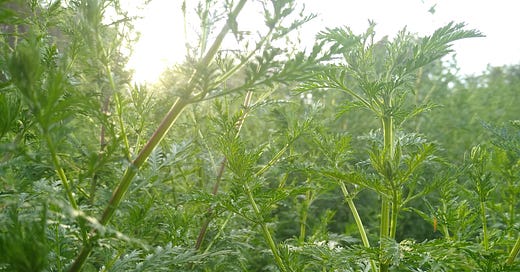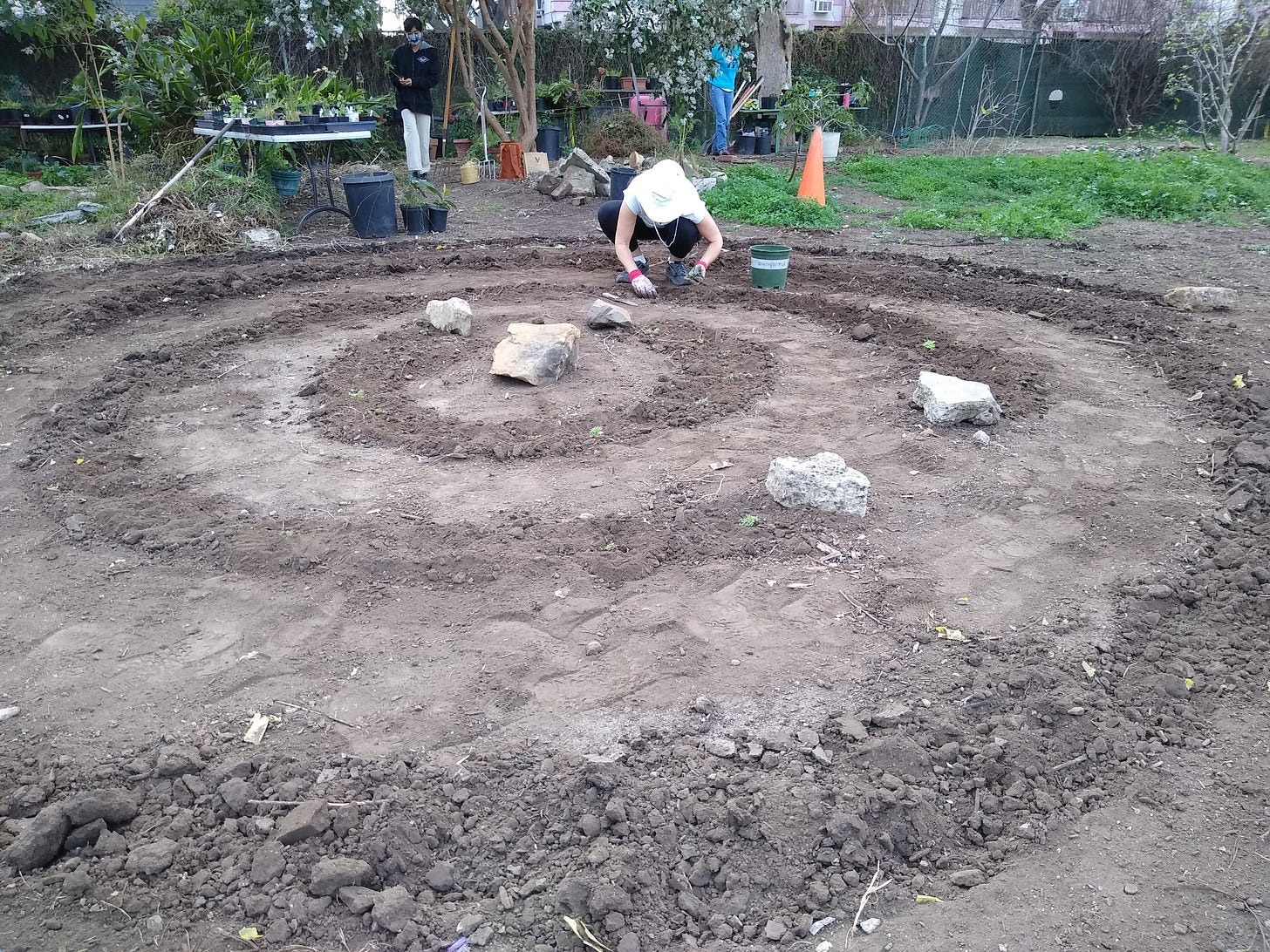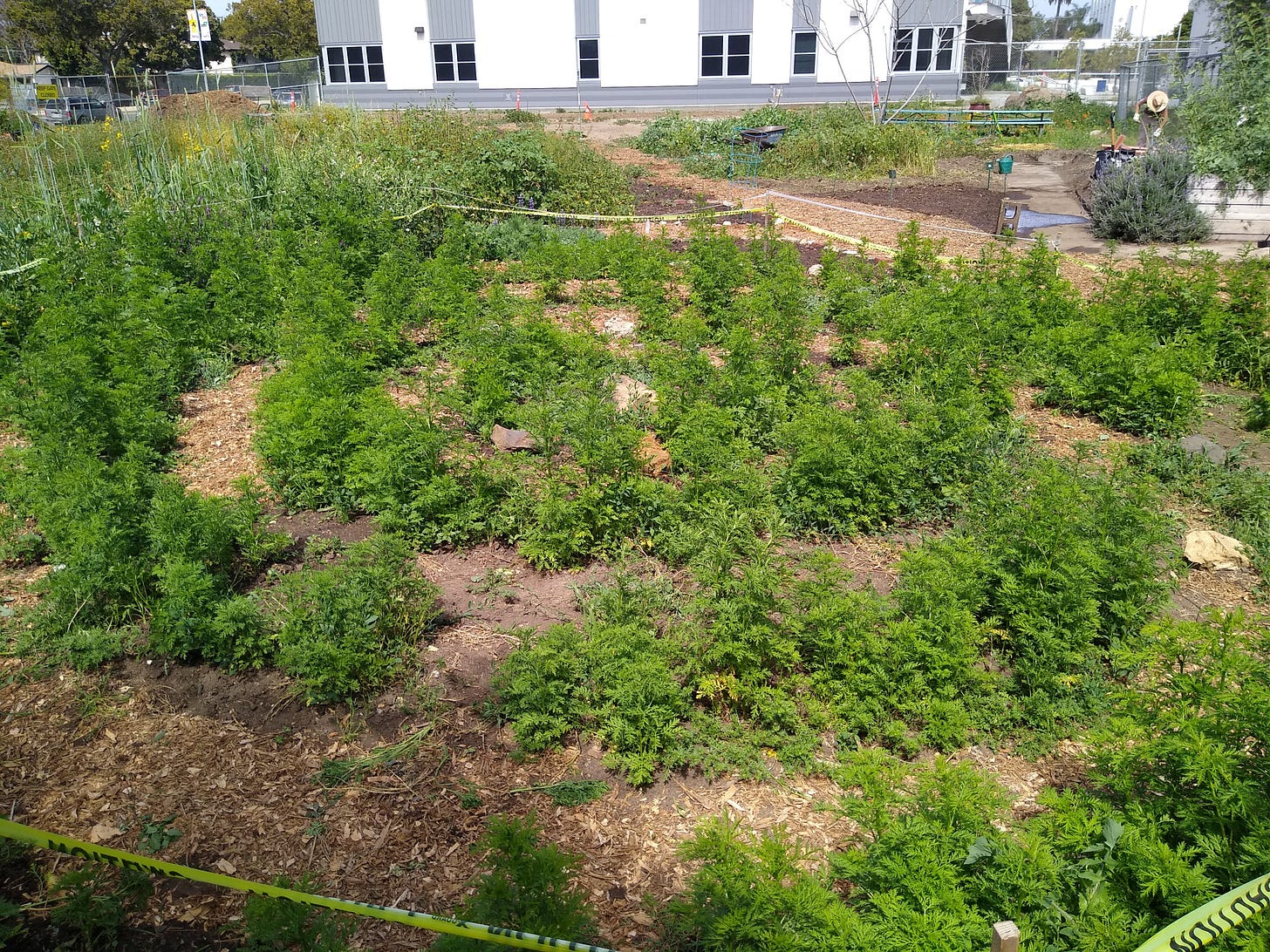The Artemisia Project
By Ingrid Schneider
In the early weeks of 2021, the first rendition of The Artemisia Project was initiated. Our volunteers took to the task and created a spiral walking path in just one afternoon. I had originally envisioned a labyrinth garden, constructed solely of one of my favorite plants, Artemisia annua.
Artemisia annua has several common names you might recognize: sweet annie, sweet wormwood, sweet sagewort, annual mugwort or annual wormwood. However, in East Asian Medicine it is called Qīng Hāo 青蒿 ("ching how”, phonetically speaking). In the Asteraceae plant family and as an ode to it's binomial nomenclature, Artemisia annua is an annual plant, yielding it's most powerful medicine before the plant starts to flower, usually by Summer Solstice. The leaves are divided by deep cuts in 2 or 3 small leaflets and are intensely fragrant and aromatic, housing all of the goodness. Most of the plants in the project were up to 6 feet tall and stepping into the center, breathing in all of it, felt like the best plant hug ever.
Wait. Did I say powerful medicine? I did! In 2015 Tú Yōuyōu ("too yo yo", pronounced like the toy) won the Nobel Prize in Physiology or Medicine for isolating a particular constituent, artemisinin, found in A.annua. She got her clues from thousand year old traditional Chinese medicinal formulas used to treat malaria. So now, The World Health Organization recognizes artemisinin to treat drug resistant malaria.
Qīng Hāo 青蒿 is in the category of Herbs that Clear Heat from Deficiency. It is bitter in taste and cold in temperature with an affinity for the Liver, Gallbladder and Kidney channels. The process of diseases with prolonged heat can injure the body fluids and disrupt the balance (of Yin and Yang) leading to symptoms such as low fever, headache and dizziness, fevers from blood deficiency or as the sequelae of febrile disease, purpuric rashes or bleeding due to heat in the blood or alternating fever and chills (of malarial disorders). While the bitter and cold of Qīng Hāo clear the heat, the aromatic nature will vent the heat from the deeper levels (yin level) of the body to the surface (yang level).
The aerial parts of the plant are used to make the medicine (leaves, stems); use fresh or cook only for a short time.
***not to be used for medical advice***
Several weeks ago, we laid the ground for our second rendition of The Artemisia Project: part art installation, part social experiment and completely fueled by volunteer efforts. We're looking forward to a bountiful harvest come early summer.
Come on down and help us tend to it and make it so.
UPCOMING WORKSHOP
Saturday, April 2nd 10-12 At the Venice High School Alumni House Join David King for a lesson on planting tomatoes!
Before We Get Done With Beets!
By David King
So while those Irish are hanging out with their holiday, I want to circle back around to BEETS.
St. Patrick's day honors a Saint and however much you can drink, so I think of this as the perfect kind of holiday falling on March 17th. I'm Irish, but I don't partake of the drink or the superstition that you have to do something to honor the day before it's over. I might be building bad-karma, but so far, not so much. I do want to take the good saint to task for the idea that promulgates planting your tomatoes on St. Pats day, I'm afraid that even a good gardener (especially if they are Italian) could trip on that idea and get all their tomatoes in the ground with a whooosh.
I don't cotton too much to the idea that anyone should get all their fruit, whatever it might be, in the ground at one time. If you are caning your tomatoes or making strawberry jam, having all your fruit get rip about the same time is plum backwards! You need to strive for a staggered planting where every little mouthful comes of age in succession.
I start our winter/spring growing season by looking at “dates to maturity” - printed on almost every seed packet – if you've ordered from a catalog its for sure in the catalog. somewhere. Look for them.
In the case of a lot of fruit, plan to have enough strawberries, apples, beets (do not sneer at my beets, dear friend! Pickled beets are a treat for all! Especially if you dislike beets! )
In the case of beets, you can choose to have pickled beets, you can plant at different times to have the pickles throughout summer into fall. I like to grow several different beets together. This morning I harvested Touch of Gold – a brilliant yellow beet with a lot of sweetness; also Crosby Egyptian Red – a lighter red that is also sweet (and much smaller than the other beets; and a sturdy dependable performer – nice large roots that will be easier to work with than many species with beets the size of the liberty bell.
Keep an eye on your beets as they form up in the ground that is getting warmer. Too many seeds in one spot will get you a mess of little beets that take up a lot of room so quickly wash the beets with warm water and a brush, yank the beets from the ground and brush off the soil and use the brush to get away the rest of the mud. Clean the outer skin (as lightly as possible) with the brush making certain you are serving beets and not rocks.
There are a lot of beet recipes online, just pick one and if it's that's bad, you can feed it to the dog although I don't do that one anymore. I mean to say, I have a very picky tendency – if you can like it, you've got a winner on your hands. I found some good beet recipes on BelllyFul.com Where the feature is roasted beets and I'll vouch for them. Remember, beets have a stronger flavor naturally, but it's not unpleasant and if you don't try it, you're missing out on some mighty good eating.
Good Luck!






